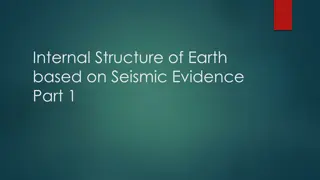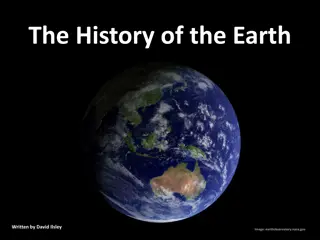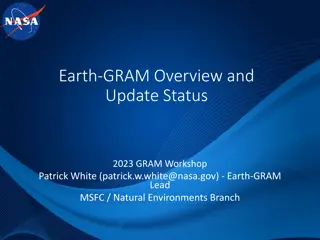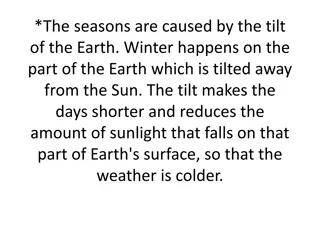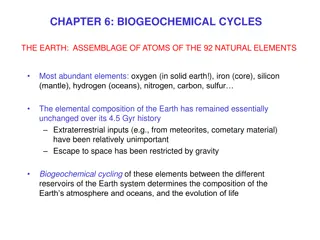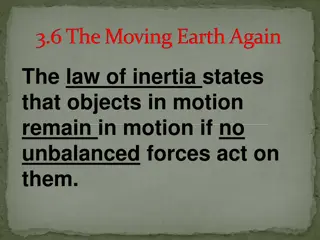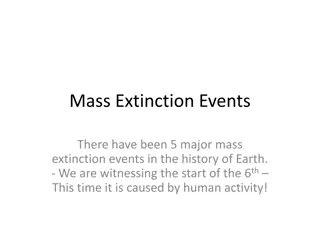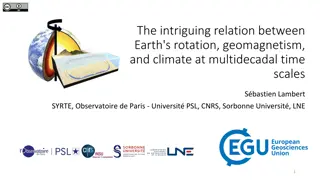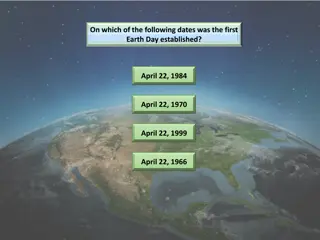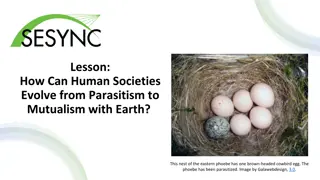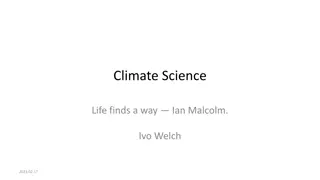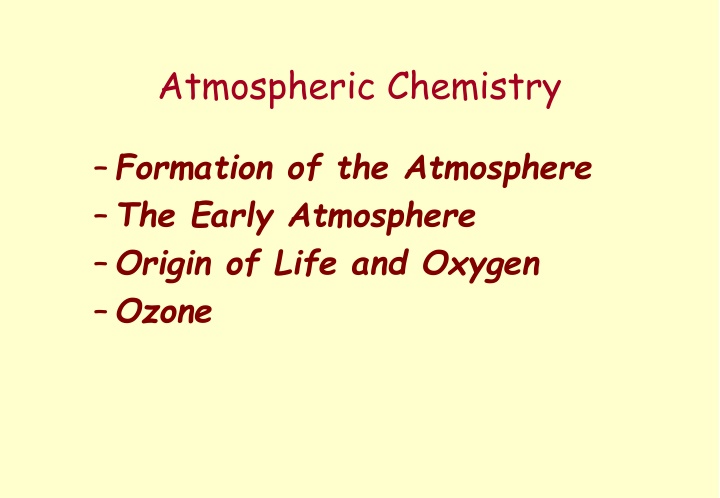
Earth's Atmospheric Chemistry, Formation, and Evolution
Explore the fascinating journey of Earth's atmosphere, from its formation and the origins of life to the impact of atmospheric chemistry on our planet. Learn about the early atmosphere, thermal consequences, mantle formation, isotope distribution, and the appearance of the atmosphere through isotope analysis. Discover how differentiation led to the creation of Earth's atmosphere and gain insights into the role of xenon isotopes in understanding atmospheric evolution.
Download Presentation

Please find below an Image/Link to download the presentation.
The content on the website is provided AS IS for your information and personal use only. It may not be sold, licensed, or shared on other websites without obtaining consent from the author. If you encounter any issues during the download, it is possible that the publisher has removed the file from their server.
You are allowed to download the files provided on this website for personal or commercial use, subject to the condition that they are used lawfully. All files are the property of their respective owners.
The content on the website is provided AS IS for your information and personal use only. It may not be sold, licensed, or shared on other websites without obtaining consent from the author.
E N D
Presentation Transcript
Atmospheric Chemistry Formation of the Atmosphere The Early Atmosphere Origin of Life and Oxygen Ozone Air Pollution Acid Rain Greenhouse Effect
Formation of the Earth Apollo Space Program (1960 s) Otto Schmidt Cosmic Dust Ball 10 km 12,000 km Heat Generated during the Process ( Collisions ) Differentiation Occurs Planet (100 million years)
Thermal Consequences Earth s Core Molten Fe ( Density 7.86 g/cc) Ni ( Density 8.9 g/cc) Outer Shell Fe2O3/ FeO ( Density 5.2/5.7 g/cc) Si/SiO2 Al/Al2O3 (Density 2.33/2.32 g/cc) ( Density 2.7/3.5 g/cc)
Formation of the Mantle The less dense material will go toward the surface (Polar Oxides of Si, Al, Fe) Separation will occur as Fe/Ni core is nonpolar MANTLE starts to form and cool (Production of Iron from Iron Ore)
Isotope Distribution of the Earth Investigation of the History of the Earth primarily relied on isotope analysis. Decay of 238U Decay of 235U And the rare gases He, Ar, Xe 4.5 Billion years Old 206Pb 207Pb
Appearance of the Atmosphere Did the atmosphere suddenly appear ? Isotope Analysis gives a clue Claude Allegre ( Rare Gases do not react readily ) Argon has three isotopes (36Ar 0.337) (38Ar 0.063) (40Ar 99.60) EC Decay 40K 40Ar ( t1/2= 1.28 x 109y ) He, Ar & Xe
Isotopes of Xe Xenon has 9 isotopes With the following distribution 124Xe 0.1%, 126Xe 0.09%, 128Xe 1.91% 129Xe 26.4%, 130Xe 4.1%, 131Xe 21.2% 132Xe 26.9%, 134Xe 10.4%, 136Xe 8.9%
Distribution of Xe isotopes Nucleosynthesis gives rise to 129Xe -Decay of 129I (t1/2= 1.6 x 107y) 129Xe The distribution of Xe isotopes in the mantle and atmosphere can give information about the Earth s Atmosphere as the outgassed distribution will vary to that of the mantle.
Differentiation The Atmosphere was formed due to OUT GASSING of the mantle (Heat) & Volcanic Activity The Mantle does not contain any 40K or 129I All 129 Xe in mantle came from 129I
Age of differentiation From the ratio of 129 Xe in the Mantle to that of 129 Xe in the Atmosphere it possible to gain some idea of the age of differentiation as the Xe due to Nucleosynthesis would have been OUTGASSED into the atmosphere.
Ratios of Isotopes The Argon trapped in Mantle evolved from the radioactive decay of 40K 40K The Xenon trapped in Mantle evolved from the radioactive decay of129I The ratio of the amount in the mantle to the atmosphere can give information about the process of differentiation..
Conclusions from Isotope Analysis If outgassing occurred at the beginning the atmosphere would not contain 40Ar4r But would contain 129Xe Results and Calculations indicate 80% to 85% of the Earth s Atmosphere was outgassed in the first million years
Collecting the evidence The other 15% has arisen due to slow release over 4.4 billion years Difficult Analytical Problem requiring Concentration of the samples Specific Choice of Sampling Sites
Early Atmosphere Majors: CO2, N2, H2O (Water Vapour) Traces: CH4, NH3, SO2, HCl Water Vapour Oceans FeO/Fe2O3 (Grand Canyon) indicates O2emerged in the atmosphere about 2 billion years ago`
Origin of Life Stanley Miller (1950) Early Earth Experimental Setup CH4, NH3, H2, H2O(g)( Atmosphere) H2O(l)( Oceans) Electrode discharge (Simulate Lightning) Analysis of Fractions
Formation of Simple Amino Acids Glycine was found How Glycine (NH2CH2COOH) Formed HCOH + NH3+ HCN NH2CH2CN + H2O Formaldehyde Cyanide Hydrogen Aminonitrile NH2CH2CN + 2 H2O NH2CH2COOH + NH3
Murchison Meteor A number of the compounds discovered in the discharge fractions are precursors to life. Years later a meteor struck at Murchison (Victoria) was also analyzed and its contents found to be similar to those of the discharge experiment of Stanley Miller
Early Energy System The first living organisms gained their energy by a fermentation of the organic soup C6H12O6 Alcohol + CO2+ Energy However there was only a limited amount of organic nutrients in the primeval soup and to sustain life. ( First Famine ). A new efficient Energy Source was required.
Role of Blue Green Algae Blue Green Algae & Photosynthetic Bacteria developed to use water as a hydrogen donor and produced dioxygen as a by product. Photosynthesis nCO2 6CO2 + nH2O ( CH2O)n + 6H20 + nO2 + 6O2 C6H12O6
Decline of Anaerobic Bacteria Problem for Anaerobic Organisms Evidence of the appearance of Oxygen is indicated in the (Red Layers) of the Grand Canyon. O2is believed to have entered the atmosphere about 1.8 Billion years ago Fe2+and oxygen reactions may have delayed entry of oxygen into the atmosphere.
Oxygen Rich Planet Oxygen Rich Planet The build up of Oxygen in the atmosphere led to the formation of the Ozone Layer at 15 to 60 km above the earth. Ozone O3absorbs harmful UV light and this allowed organisms to colonize the Water/Land/ Atmosphere interface.
Oxygen Rich Planet Respiration utilized the photosynthetic Compounds (Sugar ) to produce Energy (CH2O)n + nO2 This process was 18 times more efficient than the fermentation process . But oxygen can damage cellular material nCO2+ H2O + E
The trouble with oxygen The ultilization of oxygen in producing energy resulted in emergence Eukarotic cells which contained a nucleus which protected cellular material prone to oxidation. ( DNA)
The present atmosphere The present atmosphere has arisen from (1) The distance of the earth from the sun (2) Nature of the earth s composition (3) The rise of life.
Distance from the Sun The distance from the Sun determines the kinetic energy (KE) of the molecules in the atmosphere due to the Sun s heat and the molecule s velocity. KE = 1/2 mv2& KE = 3/2kT Where m is the mass of the molecule (Mr /NA) k is the Boltzmann constant (R/NA) ( Earth !50 x 106km) Transit of Venus Capt Cook to within 2% of the value 1788
Influence of Earths Mass The ability of molecules to remain in the atmosphere is also related to the mass of the earth. The escape Velocity Ve= (2Gm/R)1/2 m = Mass, G=Universal Gravitational Constant, R = Radius
Escape Velocity Escape Velocity (Ve) Ve= (2Gm/R)1/2 m = Mass of the Planet G= Universal Gravitational Constant, R = Radius of the Planet Escape Velocities in km/s Earth = 11.2 Venus = 10.3 Mars = 5.0
Escape Velocity The ability of molecules to remain in an atmosphere is related to the mass. Density Diameter Distance from Sun Mars 3.94g/ml 6794km 227.9 Mkm Earth 5.52g/ml 12756km 149.6 Mkm The Molecule s Escape Velocity and nature of the molecules determines the composition of the atmosphere.
No H or He in Earths Atmosphere At 600 K (Upper Atmosphere ) For H atoms 1 in 106exceeds the escape velocity.This is High enough for rapid depletion of H from the atmosphere As a result all the Hydrogen on earth is present in a bound state. (Water, Organic material)
Little CO2in atmosphere For Oxygen only 1 in 1084atoms exceeds the escape velocity .This indicates negligible depletion of Oxygen. Presence of Life on Earth has removed Carbon dioxide from the Atmosphere and given rise to oxygen. Shellfish/Coral. ( Calcium Carbonate and Plant Material )
Earth ,Venus & Mars Surface Characteristics of Planets Temperature Pressure (bar)* Venus 732 K (459oC) 90 Earth 288 K ( 15oC ) 1 (101325Pa) Mars 223 K (-55oC ) 0.006 *1 bar = 100,000Pa = 10m in depth of the Ocean
Distribution of Gases on Earth Venus & Mars Composition of Planet s Atmospheres in % CO2 Venus 96.5 3.5 0.015 Earth 0.03 78.1 20.9 (varies) Mars 95.3 2.7 < 0.1 0.03 N2 O2 SO2 H2O
Role of Shellfish Presence of Life on Earth has removed Carbon dioxide from the Atmosphere and given rise to oxygen. Shellfish/Coral. in the Sea,Air,Land Interface has immobilized Carbon dioxide as Calcium Carbonate while Photosynthesis has given rise to oxygen and Plant Material
Triple point of H2O 380 T e m p er at u re Venus Triple Point VAPOUR WATER Earth K ICE Mars 200 10-6 1 P(H2O) in Atmospheres
Water ( Solid,Liquid, Gas) The Surface temperature of the Earth at 1 atmosphere Pressure is close to the Triple Point for water.Water is the only compound that can exits in the environment as a Solid, Liquid and Gas simultaneously. The thermodynamic properties of Water have been essential in determining our present climate and support of life.
Super Greenhouse & Acid Rain On Venus ,the high level of CO2 and its distance from the Sun have lead to a super greenhouse effect and Sulphuric Acid Rain. Where the surface pressure in 90 times that of Earth s ( 900 m in the Ocean) and surface temperature is about 460oC (Melting point of Zn = 419oC)
Current Atmosphere Composition of Current Atmosphere %Vol N2, O2, Ar, CO2, H2O 78.08 20.95 0.93 0.03 (Variable) ppm Ne He K CH4 18 5.2 1.1 1.25 Early Atmosphere Rich in CO2, CH4
Present Level of Oxygen The present level of Oxygen in the atmosphere is balanced at a such a level that less would impede survival of a number of organisms while more would lead to a greater probability of fires. At 25 % oxygen damp twigs and grass of a rain forest would ignite.
Structure of Atmosphere Earth s Atmosphere REGION 500 km (1200oC) O2+, O+, NO+ 3 x 10-6 atm Thermosphere 85 km (-92oC) O2+, NO+ 0.001 atm Mesosphere 50 km (-2oC) O3 Stratosphere 0.1 atm 10-16 km (-56oC) N2,O2,CO2,H2O 1atm Troposphere 15oC Earth s Surface
Ozone Layer Ozone in the Stratosphere 16 - 50km above the Earth s Surface acts as a blanket preventing harmful radiation that can marked affect living material from reaching the surface of the Earth.
Ozone and Radiation Oxygen that lies above the stratosphere filters out UV light 120nm - 220nm Ozone O3. In the Stratosphere filters out UV light 220nm - 320nm Regions UV C 200nm - 280nm UV B 280nm - 320nm UV A 320nm - 400nm ( less harm)
Effects of Reduction in Ozone (Effects of Reduction) 1% Reduction In O3 2% increase in UV-B Skin sunburns, tans, Skin cancer Absorbed by DNA DNA damage Possible eye cataracts Interferes with photosynthesis Organisms in 1st 5metre of the Oceans at risk ( phytoplankton in particular )
Chlorofluorocarbons & Ozone Destruction of the Ozone Layer discovered in 1970 s by CFC s ( Chlorofluorocarbons) First synthesized Swartz (1892) Used as refrigerants 1928 (Midgely & Henne) CCl4 + xHF CCl(4-x)Fx + HCl (Aerosol Propellants & Air conditioners)
Ozone Protection Protection O2 + h 2O. O. + O2 O3 O3 + h O. +O2 ( UV-B)
Ozone Destruction CFCl3 Cl. Chlorine Destruction (UV-C, UV-B) Radical Cl. + O3 O2 + ClO. ClO. + O. Cl. + O2 ClO. + ClO.ClOOCl (relatively stable)
Control of CFCs CFC s are now under strict control and their use has been curtailed. Australia signed the international treaty. The Montreal Protocol in June 1988 which has a program controlling the use and reduction of CFC s.
Uses of CFCs Compound CFC- 11 CFCl3 Refrigeration, aerosol, foam CFC-12 CF2Cl2 sterilization, cosmetics food freezing, pressurized blowers. CFC-113 CCl3CF3 solvent, cosmetics Halon 1301 CBrF3 fire fighting (discontinued) Use
Lifetime of CFCs CompoundOzone Depleting Lifetime(yrs) Potential CFC- 11 1.0 CFC-12 1.0 100 - 140 CFC-113 0.8 100 - 134 CFC-115 0.6 500 CCl4 1.2 50 - 69 Halon 1301 10 110 65 -75
Naming of CFCs ( 90 Rule) CFC s name is related to its Formula. CFC 123 123 + 90 = 213 The remaining bonds are allocated to Cl or Br C = 2 , H =1 , F = 3 , Cl = ( 8 - 6) = 2 CFC 123 is CF3CHCl2 Letters with the number indicate an isomer. CH F
Chloromonoxide Evidence for the destruction has been linked to the catalytically active Chloro monoxide ClO. & Ozone profiles as one goes South. It is interesting to note how little Chloro monoxide effects the amounts of Ozone.




